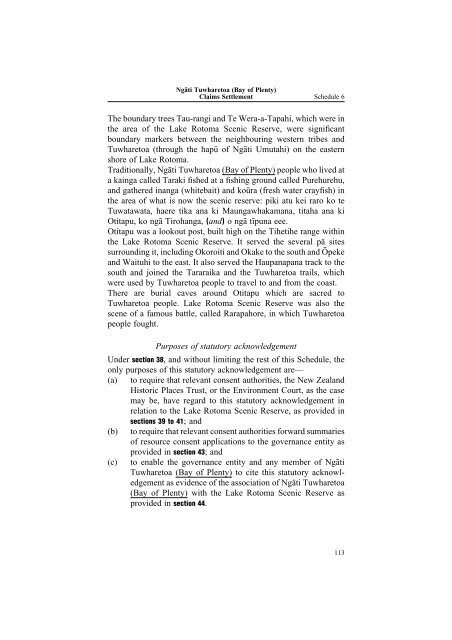Ng¯ati Tuwharetoa (Bay of Plenty) Claims Settlement Bill
Ng¯ati Tuwharetoa (Bay of Plenty) Claims Settlement Bill
Ng¯ati Tuwharetoa (Bay of Plenty) Claims Settlement Bill
Create successful ePaper yourself
Turn your PDF publications into a flip-book with our unique Google optimized e-Paper software.
Ngāti <strong>Tuwharetoa</strong> (<strong>Bay</strong> <strong>of</strong> <strong>Plenty</strong>)<br />
<strong>Claims</strong> <strong>Settlement</strong> Schedule 6<br />
The boundary trees Tau-rangi and Te Wera-a-Tapahi, which were in<br />
the area <strong>of</strong> the Lake Rotoma Scenic Reserve, were significant<br />
boundary markers between the neighbouring western tribes and<br />
<strong>Tuwharetoa</strong> (through the hapū <strong>of</strong> Ngāti Umutahi) on the eastern<br />
shore <strong>of</strong> Lake Rotoma.<br />
Traditionally, Ngāti <strong>Tuwharetoa</strong> (<strong>Bay</strong> <strong>of</strong> <strong>Plenty</strong>) people who lived at<br />
a kainga called Taraki fished at a fishing ground called Purehurehu,<br />
and gathered inanga (whitebait) and koūra (fresh water crayfish) in<br />
the area <strong>of</strong> what is now the scenic reserve: piki atu kei raro ko te<br />
Tuwatawata, haere tika ana ki Maungawhakamana, titaha ana ki<br />
Otitapu, ko ngā Tirohanga, (and) o ngā tīpuna eee.<br />
Otitapu was a lookout post, built high on the Tihetihe range within<br />
the Lake Rotoma Scenic Reserve. It served the several pā sites<br />
surrounding it, including Okoroiti and Okake to the south and Ōpeke<br />
and Waituhi to the east. It also served the Haupanapana track to the<br />
south and joined the Tararaika and the <strong>Tuwharetoa</strong> trails, which<br />
were used by <strong>Tuwharetoa</strong> people to travel to and from the coast.<br />
There are burial caves around Otitapu which are sacred to<br />
<strong>Tuwharetoa</strong> people. Lake Rotoma Scenic Reserve was also the<br />
scene <strong>of</strong> a famous battle, called Rarapahore, in which <strong>Tuwharetoa</strong><br />
people fought.<br />
Purposes <strong>of</strong> statutory acknowledgement<br />
Under section 38, and without limiting the rest <strong>of</strong> this Schedule, the<br />
only purposes <strong>of</strong> this statutory acknowledgement are—<br />
(a) to require that relevant consent authorities, the New Zealand<br />
Historic Places Trust, or the Environment Court, as the case<br />
may be, have regard to this statutory acknowledgement in<br />
relation to the Lake Rotoma Scenic Reserve, as provided in<br />
sections 39 to 41; and<br />
(b) to require that relevant consent authorities forward summaries<br />
<strong>of</strong> resource consent applications to the governance entity as<br />
provided in section 43; and<br />
(c) to enable the governance entity and any member <strong>of</strong> Ngāti<br />
<strong>Tuwharetoa</strong> (<strong>Bay</strong> <strong>of</strong> <strong>Plenty</strong>) to cite this statutory acknowledgement<br />
as evidence <strong>of</strong> the association <strong>of</strong> Ngāti <strong>Tuwharetoa</strong><br />
(<strong>Bay</strong> <strong>of</strong> <strong>Plenty</strong>) with the Lake Rotoma Scenic Reserve as<br />
provided in section 44.<br />
113






![Full evidence text [PDF 8908k] - New Zealand Parliament](https://img.yumpu.com/14025494/1/184x260/full-evidence-text-pdf-8908k-new-zealand-parliament.jpg?quality=85)
![−3 JUN 2009 IRELEASED] - New Zealand Parliament](https://img.yumpu.com/12829724/1/185x260/3-jun-2009-ireleased-new-zealand-parliament.jpg?quality=85)
![Full paper text [PDF 3515k] - New Zealand Parliament](https://img.yumpu.com/11267192/1/184x260/full-paper-text-pdf-3515k-new-zealand-parliament.jpg?quality=85)


![Full evidence text [PDF 9k] - Parliament](https://img.yumpu.com/7938085/1/184x260/full-evidence-text-pdf-9k-parliament.jpg?quality=85)




